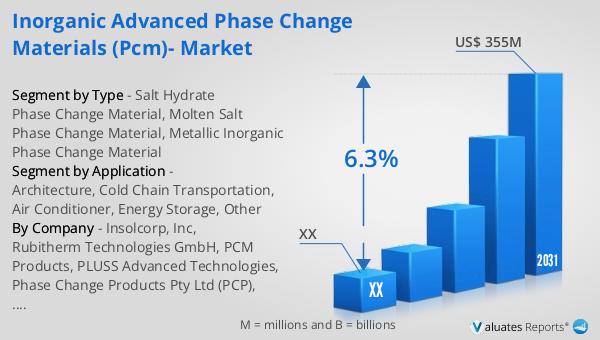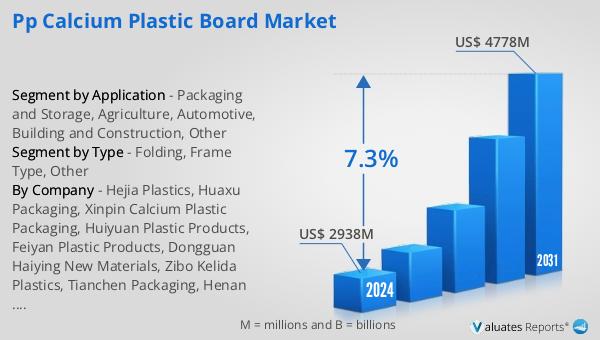What is Inorganic Advanced Phase Change Materials (PCM)- Global Market?
Inorganic Advanced Phase Change Materials (PCM) are specialized substances that absorb and release thermal energy during the process of melting and freezing. These materials are used to maintain a consistent temperature in various applications, making them highly valuable in industries that require temperature regulation. The global market for these materials is expanding due to their efficiency in energy conservation and their ability to reduce greenhouse gas emissions. Inorganic PCMs, such as salt hydrates, molten salts, and metallic compounds, are particularly favored for their high thermal conductivity and stability over a wide range of temperatures. These materials are crucial in sectors like construction, transportation, and energy storage, where maintaining specific temperature conditions is essential. As industries continue to seek sustainable and efficient energy solutions, the demand for inorganic advanced PCMs is expected to grow, driven by their ability to enhance energy efficiency and reduce operational costs. The market's growth is also supported by technological advancements that improve the performance and cost-effectiveness of these materials, making them more accessible for various applications.

Salt Hydrate Phase Change Material, Molten Salt Phase Change Material, Metallic Inorganic Phase Change Material in the Inorganic Advanced Phase Change Materials (PCM)- Global Market:
Salt Hydrate Phase Change Materials are a prominent type of inorganic PCM, known for their ability to store and release large amounts of energy during phase transitions. These materials are composed of salt and water, forming a crystalline structure that melts and solidifies at specific temperatures. Salt hydrates are widely used due to their high latent heat capacity, which allows them to store more energy compared to other materials. They are also relatively inexpensive and non-toxic, making them an attractive option for various applications. However, they can suffer from issues like supercooling and phase separation, which can affect their performance. To address these challenges, researchers are developing additives and encapsulation techniques to enhance their stability and reliability. Molten Salt Phase Change Materials, on the other hand, are used primarily in high-temperature applications, such as solar power plants and industrial heat storage. These materials can operate at temperatures exceeding 300°C, making them suitable for capturing and storing solar energy during the day and releasing it at night. Molten salts are favored for their high thermal conductivity and ability to remain stable over multiple thermal cycles. However, they require careful handling and containment due to their corrosive nature and high operating temperatures. Metallic Inorganic Phase Change Materials are another category, known for their excellent thermal conductivity and ability to withstand extreme temperatures. These materials, often composed of metals or metal alloys, are used in applications where rapid heat transfer is required, such as in electronics cooling and aerospace. Despite their high cost, metallic PCMs are valued for their durability and efficiency in transferring heat quickly. The global market for inorganic advanced PCMs is driven by the need for efficient energy storage solutions and the growing demand for sustainable technologies. As industries continue to innovate and improve the performance of these materials, their applications are expected to expand, offering new opportunities for energy conservation and temperature regulation across various sectors.
Architecture, Cold Chain Transportation, Air Conditioner, Energy Storage, Other in the Inorganic Advanced Phase Change Materials (PCM)- Global Market:
Inorganic Advanced Phase Change Materials (PCM) are increasingly being utilized in a variety of applications due to their ability to efficiently manage thermal energy. In architecture, these materials are integrated into building materials to enhance energy efficiency and indoor comfort. By incorporating PCMs into walls, ceilings, and floors, buildings can maintain a stable indoor temperature, reducing the need for heating and cooling systems. This not only lowers energy consumption but also contributes to a more sustainable and environmentally friendly building design. In the realm of cold chain transportation, inorganic PCMs play a crucial role in maintaining the required temperature for perishable goods during transit. By using PCMs in refrigerated trucks and containers, companies can ensure that food, pharmaceuticals, and other temperature-sensitive products remain within the desired temperature range, reducing spoilage and waste. In air conditioning systems, PCMs are used to store excess thermal energy during off-peak hours and release it during peak demand, improving the efficiency of the system and reducing energy costs. Energy storage is another significant application of inorganic PCMs, particularly in renewable energy systems. By storing excess energy generated from solar or wind power, PCMs can help balance supply and demand, ensuring a steady energy supply even when the sun isn't shining or the wind isn't blowing. This capability is essential for integrating renewable energy sources into the grid and reducing reliance on fossil fuels. Other applications of inorganic PCMs include electronics cooling, where they help manage heat generated by electronic devices, and textiles, where they are used to create temperature-regulating fabrics. As the demand for energy-efficient and sustainable solutions continues to grow, the use of inorganic advanced PCMs is expected to expand across various industries, offering new opportunities for innovation and energy conservation.
Inorganic Advanced Phase Change Materials (PCM)- Global Market Outlook:
The global market for Inorganic Advanced Phase Change Materials (PCM) is projected to experience significant growth in the coming years. In 2024, the market was valued at approximately US$ 233 million, and it is anticipated to reach a revised size of US$ 355 million by 2031, reflecting a compound annual growth rate (CAGR) of 6.3% during the forecast period from 2025 to 2031. The market is dominated by the top three players, who collectively hold about 61% of the market share. Europe emerges as the largest market, accounting for approximately 45% of the global share, followed closely by the Asia-Pacific region with a 43% share, and North America with a 10% share. Among the different product types, Salt Hydrate Phase Change Material stands out as the largest segment, representing a substantial 79% of the market. In terms of application, Cold Chain Transportation is the leading field, capturing about 30% of the market share. This growth is driven by the increasing demand for energy-efficient solutions and the need for temperature regulation across various industries. As the market continues to evolve, companies are focusing on innovation and technological advancements to enhance the performance and cost-effectiveness of inorganic advanced PCMs, further driving their adoption in diverse applications.
| Report Metric | Details |
| Report Name | Inorganic Advanced Phase Change Materials (PCM)- Market |
| Forecasted market size in 2031 | US$ 355 million |
| CAGR | 6.3% |
| Forecasted years | 2025 - 2031 |
| Segment by Type |
|
| Segment by Application |
|
| By Region |
|
| By Company | Insolcorp, Inc, Rubitherm Technologies GmbH, PCM Products, PLUSS Advanced Technologies, Phase Change Products Pty Ltd (PCP), Guangzhou Zhongjia, Climator Sweden AB, BOCA International, AXIOTHERM |
| Forecast units | USD million in value |
| Report coverage | Revenue and volume forecast, company share, competitive landscape, growth factors and trends |
